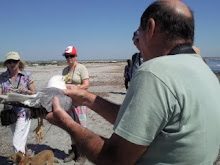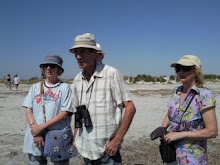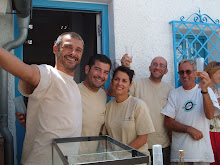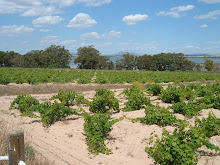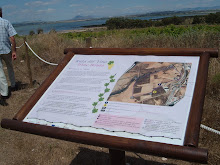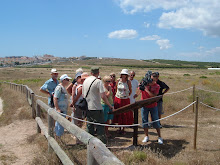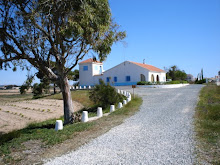People living on the perimeter of the Natural Park of La-Mata-Torrevieja may have noticed in the last few weeks, a team of Natural Park workers pulling up plants and cutting down trees within the park and on its perimeter.
This is all part of a campaign now in full swing to rid the Park of foreign invasive plants, since the government of Valencia decreed in 2007 that only native vegetation should be present in the parks of Valencia Province.
Those householders who live on the edges of the Park have done their best in their way to brighten up their environment by ‘snatching’ extra bits of garden outside of their own property but unfortunately many of the plants they planted are not at all suitable because they have spread – in some cases like wildfire – into the Park to the detriment of native plants. Some of these, familiar to us all, are Prickly Pear, Aloe Yucca, Octopus Plant, Cat’s Claw (which some of us know as Mile a Minute, for obvious reasons), Acacia and worst of all, Spanish flag which has lots of pretty orange-red flowers.
All of these grow unchecked and choke the indigenous species and eventually take over. Worst of all many of these plants encourage mosquitoes – hence the problems around the salt lakes, which in themselves do not offer a friendly environment to the mosquitoes since the native plants which grow on the saline territory have no attraction for them. Where the alien plants thrive – so do the mosquitoes.
The campaign in the Park is to rid the areas within it and on its perimeter of these invasive plants. Information about the campaign will be given to those who live in Torreta 3 and El Chaparral in particular, and informative talks are to be given to the Presidents and neighbours of these areas.
The Park staff will be helped by groups of the Asociación of Volunteers of la Mata-Torrevieja, an international group, who help on a day to day basis with tasks in the Park. This campaign is ongoing and it will take many years to achieve the eradication of all the ‘bad’ plants. In their place native plants will be planted and the householders will be given alternative ‘good’ plants to replace those which are to be removed from the perimeter gardens.
Looking much further into the future if people are found tipping garden rubbish containing unsuitable plant refuse, or planting unsuitable plants, fines will be issued.
Monday 30 November 2009
Saturday 28 November 2009
The Park Environment
THE CHARACTER OF THE NATURAL PARK OF THE LAKES OF LA MATA AND TORREVIEJA.
In the Natural Park of the lakes of La Mata and Torrevieja we can enjoy diverse ecosystems with vegetation and fauna which adapt to the high saline level of the terrain and the scarcity of rain water.
HOW SPECIES ADAPT TO THE HIGH SALINITY.
Plant species
Many of the plants of the Park are "halofilas", that is, those which live in an environment rich in salt. To cope with the salinity of the land and the scarcity of water they have evolved various strategies:
Expelling salt through their leaves.
Concentrating salt on the inside of their leaves or on the edges of their stems.
Animal species
The most characteristic animal species in the Park is the aquatic invertebrate called Artemia. This is a little crustacean which is abundant in salt marshes and salt lakes.
It forms part of the plankton of the lake together with other organisms such as “protozoos” (small bacteria), rotifers (tiny aquatic animals with a semi-flexible telescopic body), dipterous and coleopterons larvae (flies and beetles).
The Artemia can live in areas 2 to 6 times more saline than sea water (from 80 to 220 grams per litre).
It constitutes the fundamental diet of the many birds which come to this area,together with mosquito larvae.
Why are some birds pink?
The Artemia are reddish in colour in the high salinity due to the increase of haemoglobin in their hemolymph (the circulatory liquid in the body), which aids their breathing. In addition this is because of the carotene pigments ingested with the red bacteria and micro algae in this highly saline water.
The bacteria are red in colour due to some carotene pigments which protect them from solar rays. The micro algae of genus Dunaliella also acquire a red hue because of these carotene pigments, which appear when the saline content is greater than 250 grams of salt per litre.
The flamingo and the slender billed gull have a rosy hue in their plumage because of the Artemia which form part of their diet.
The Artemia and its adaptation to the salinity.
When the conditions of the salt lakes are acceptable in terms of low salinity and temperature, with sufficient oxygen and food in the area, the Artemia will reproduce continually, ejecting live larvae into the water.
When the level of the brine is lowered by evaporation and the salinity increases, the Artemia reproduces by dropping resistant eggs (‘quistes’: cysts) before dying. These resistant cysts accumulate on the banks of the lake and survive the inclement climatic conditions of the summer (heat, drought, lack of oxygen etc). When autumn arrives and the saline content decreases on the arrival of the first rains, the resistant eggs of the Artemia revive, new larvae are born and the cycle begins again.
THE DIFFERENT AREAS
The wet areas like the Natural Park of the Lakes of La Mata and Torrevieja are vital for the migratory birds which make long journeys from temperate or cold Europe to Africa.
The water channels
The lakes of the Natural Park communicate with the sea by means of artificial channels which permit water to flow from the sea into the lakes. The water flows by gravity since both lakes are below sea level. Due to the water going into the channels various marine species can be seen.
The lakes and the marsh lands
The lakes contain a very high level of salt. Around the lakes marsh land is to be found. The geographical characteristics of these communities depend completely on the morphology of the land, the nearness to water and the corresponding salinity of the water.
The scrubland
There is vegetation around the marsh land which has a huge diversity of bushes and herbs which adapt very well to the scarcity of rain. The scrubland is essential for the life of many animals which find their food and shelter there. These animals are also to be found in the cultivated areas near to the vines, the market gardens, irrigation pools and drainage areas of the market gardens.
The Pine wood
The pines (piñonero) produce kernels which can be eaten, and the carrasco pines can be found in the southern zone and the southeast of the La Mata lake. These result from high levels of reforestation carried out in the 50’s and 70’s. During the 50’s there was also reforestation of eucalyptus which is found in the eastern area of the La Mata Lake.
THE PARK, A FOUNT OF NATURAL RESOURCES.
The Natural Park of the Lagunas of La Mata and Torrevieja has been from the beginning of time an area inhabited by humans in search of very varied natural resources.
Salt and its extraction
The use of salt from the lakes of Torrevieja and La Mata dates from Roman times, although the first written documents are from the 13th century.
At this time, salt was extracted from the lake edges, and the lakes remained empty for a large part of the year.
It was in 1841 during the time of D. José de Salamanca, that the current basis for harvesting the salt was established.
Since 1972 saturated brine, which comes from a deposit (resulting from erosion) of salt in Pinoso (Alicante), has been brought to the Torrevieja lake, and by this means the production of salt has been doubled.
800,000 tonnes of salt per year is exported mainly to the United States and the north of Europe.
The vines of La Mata are the few which resisted the terrible plague of Philoxera which came at the end of the 19th century.
Cultivation of the vines is emphasised by the special conditions of the area and also for the role it carries out in the conservation of the biodiversity. In addition is has great importance for the landscape and also cultural significance
The vines of La Mata provide a suitable environment for some birds in the Park such as the Alcaraván Commún, Burhinos oedicnemus, or Stone Curlew, which finds its nourishment here as well as a suitable place to nest.
In these vineyards and their surroundings we find one of the few populations of Paratriodonta alicantina, which is to be found only in the south east of Spain.
Muscatel grape:
A variety which needs sunshine and also the influence of the sea. It has a powerful aromatic fragrance and high sugar content, and also serves two purposes: it can be consumed as a table grape and can also be used in making the characteristic wine of La Mata.
Merseguera grape:
This is the most characteristic vine of the Valencia region. With this, wine is made which is easy to drink, with herbaceous, fresh nuances, and a certain aftertaste of bitter almonds.
The plants which grow on the salt marshes
In the Torrevieja area the collecting as well as the cultivation of plants was a popular activity, the plants being used for burning in order to obtain blocks of caustic soda. This task had certain similarities with the burning of wood to obtain charcoal, although it was a much more delicate process.
Esparto grass was always a much prized plant, since it had excellent fibre for weaving strong ropes or for making different articles used in daily life.
The sodium carbonate extracted was used to make glass. The sodium carbonate of lesser quality was used for making soap.
THE VALUABLE RESOURCES AND HOW TO PROTECT THEM
The lakes of La Mata and Torrevieja form an ecosystem which has great ecological value, because of their endemic characteristics which are of great importance to aquatic birds. For this reason amongst others, the lakes form part of the natural heritage of our country.
To guarantee the quality of the ecosystems of the lakes, the area was designated a Natural Area in 1988. In 1996 protection was increased when it was declared a Natural Park.
The Park is a collective heritage which must be protected for all of us because of its great ecological and social value.
Ecological wealth
Species which are vulnerable and in danger of extinction.
Important areas for birds.
The marshlands are one of the ecosystems which have the greatest biodiversity of species.
SOCIAL VALUES
Observation and study of Nature
Farming and salt based activity.
The landscape as an element of aesthetic recreation.
THE PARK, A RESPONSIBILITY FOR ALL OF US.
Administration
The Natural Park of the Lagunas of La Mata and Torrevieja is administered taking into account the environmental and the socio-economic factors of the area by means of:
Plan Rector de Uso y Gestión (PRUG)
Plan de Ordenación de los Recursos Naturales (PORN).
The Scientists
Main principles for tasks at the present time:
Tracking the birds
Administration of micro reserves
Investigation and updating the agricultural sector
Study of invertebrates (Artemia) and the entomology of the animals (ants, insects).
The people
Thanks to the collaboration of the landowners, local populace and visitors, the conservation of our patrimony continues, a duty to future generations, but also a gift to each and every one of us because we have the opportunity to enjoy an area in which we can observe the fauna, flora and the countryside, in addition to enjoying ourselves and leading a healthy lifestyle.
HOW SHOULD WE OBSERVE THE BIRDS?
ADVICE
Birds have a very good sense of hearing and sight so that we should always move carefully and observe them in silence.
We should note, above all:
The colour of their feathers
Their song
The method of flight
The shape of their beak, neck, tail, feet etc.
In the Natural Park of the lakes of La Mata and Torrevieja we can enjoy diverse ecosystems with vegetation and fauna which adapt to the high saline level of the terrain and the scarcity of rain water.
HOW SPECIES ADAPT TO THE HIGH SALINITY.
Plant species
Many of the plants of the Park are "halofilas", that is, those which live in an environment rich in salt. To cope with the salinity of the land and the scarcity of water they have evolved various strategies:
Expelling salt through their leaves.
Concentrating salt on the inside of their leaves or on the edges of their stems.
Animal species
The most characteristic animal species in the Park is the aquatic invertebrate called Artemia. This is a little crustacean which is abundant in salt marshes and salt lakes.
It forms part of the plankton of the lake together with other organisms such as “protozoos” (small bacteria), rotifers (tiny aquatic animals with a semi-flexible telescopic body), dipterous and coleopterons larvae (flies and beetles).
The Artemia can live in areas 2 to 6 times more saline than sea water (from 80 to 220 grams per litre).
It constitutes the fundamental diet of the many birds which come to this area,together with mosquito larvae.
Why are some birds pink?
The Artemia are reddish in colour in the high salinity due to the increase of haemoglobin in their hemolymph (the circulatory liquid in the body), which aids their breathing. In addition this is because of the carotene pigments ingested with the red bacteria and micro algae in this highly saline water.
The bacteria are red in colour due to some carotene pigments which protect them from solar rays. The micro algae of genus Dunaliella also acquire a red hue because of these carotene pigments, which appear when the saline content is greater than 250 grams of salt per litre.
The flamingo and the slender billed gull have a rosy hue in their plumage because of the Artemia which form part of their diet.
The Artemia and its adaptation to the salinity.
When the conditions of the salt lakes are acceptable in terms of low salinity and temperature, with sufficient oxygen and food in the area, the Artemia will reproduce continually, ejecting live larvae into the water.
When the level of the brine is lowered by evaporation and the salinity increases, the Artemia reproduces by dropping resistant eggs (‘quistes’: cysts) before dying. These resistant cysts accumulate on the banks of the lake and survive the inclement climatic conditions of the summer (heat, drought, lack of oxygen etc). When autumn arrives and the saline content decreases on the arrival of the first rains, the resistant eggs of the Artemia revive, new larvae are born and the cycle begins again.
THE DIFFERENT AREAS
The wet areas like the Natural Park of the Lakes of La Mata and Torrevieja are vital for the migratory birds which make long journeys from temperate or cold Europe to Africa.
The water channels
The lakes of the Natural Park communicate with the sea by means of artificial channels which permit water to flow from the sea into the lakes. The water flows by gravity since both lakes are below sea level. Due to the water going into the channels various marine species can be seen.
The lakes and the marsh lands
The lakes contain a very high level of salt. Around the lakes marsh land is to be found. The geographical characteristics of these communities depend completely on the morphology of the land, the nearness to water and the corresponding salinity of the water.
The scrubland
There is vegetation around the marsh land which has a huge diversity of bushes and herbs which adapt very well to the scarcity of rain. The scrubland is essential for the life of many animals which find their food and shelter there. These animals are also to be found in the cultivated areas near to the vines, the market gardens, irrigation pools and drainage areas of the market gardens.
The Pine wood
The pines (piñonero) produce kernels which can be eaten, and the carrasco pines can be found in the southern zone and the southeast of the La Mata lake. These result from high levels of reforestation carried out in the 50’s and 70’s. During the 50’s there was also reforestation of eucalyptus which is found in the eastern area of the La Mata Lake.
THE PARK, A FOUNT OF NATURAL RESOURCES.
The Natural Park of the Lagunas of La Mata and Torrevieja has been from the beginning of time an area inhabited by humans in search of very varied natural resources.
Salt and its extraction
The use of salt from the lakes of Torrevieja and La Mata dates from Roman times, although the first written documents are from the 13th century.
At this time, salt was extracted from the lake edges, and the lakes remained empty for a large part of the year.
It was in 1841 during the time of D. José de Salamanca, that the current basis for harvesting the salt was established.
Since 1972 saturated brine, which comes from a deposit (resulting from erosion) of salt in Pinoso (Alicante), has been brought to the Torrevieja lake, and by this means the production of salt has been doubled.
800,000 tonnes of salt per year is exported mainly to the United States and the north of Europe.
The vines of La Mata are the few which resisted the terrible plague of Philoxera which came at the end of the 19th century.
Cultivation of the vines is emphasised by the special conditions of the area and also for the role it carries out in the conservation of the biodiversity. In addition is has great importance for the landscape and also cultural significance
The vines of La Mata provide a suitable environment for some birds in the Park such as the Alcaraván Commún, Burhinos oedicnemus, or Stone Curlew, which finds its nourishment here as well as a suitable place to nest.
In these vineyards and their surroundings we find one of the few populations of Paratriodonta alicantina, which is to be found only in the south east of Spain.
Muscatel grape:
A variety which needs sunshine and also the influence of the sea. It has a powerful aromatic fragrance and high sugar content, and also serves two purposes: it can be consumed as a table grape and can also be used in making the characteristic wine of La Mata.
Merseguera grape:
This is the most characteristic vine of the Valencia region. With this, wine is made which is easy to drink, with herbaceous, fresh nuances, and a certain aftertaste of bitter almonds.
The plants which grow on the salt marshes
In the Torrevieja area the collecting as well as the cultivation of plants was a popular activity, the plants being used for burning in order to obtain blocks of caustic soda. This task had certain similarities with the burning of wood to obtain charcoal, although it was a much more delicate process.
Esparto grass was always a much prized plant, since it had excellent fibre for weaving strong ropes or for making different articles used in daily life.
The sodium carbonate extracted was used to make glass. The sodium carbonate of lesser quality was used for making soap.
THE VALUABLE RESOURCES AND HOW TO PROTECT THEM
The lakes of La Mata and Torrevieja form an ecosystem which has great ecological value, because of their endemic characteristics which are of great importance to aquatic birds. For this reason amongst others, the lakes form part of the natural heritage of our country.
To guarantee the quality of the ecosystems of the lakes, the area was designated a Natural Area in 1988. In 1996 protection was increased when it was declared a Natural Park.
The Park is a collective heritage which must be protected for all of us because of its great ecological and social value.
Ecological wealth
Species which are vulnerable and in danger of extinction.
Important areas for birds.
The marshlands are one of the ecosystems which have the greatest biodiversity of species.
SOCIAL VALUES
Observation and study of Nature
Farming and salt based activity.
The landscape as an element of aesthetic recreation.
THE PARK, A RESPONSIBILITY FOR ALL OF US.
Administration
The Natural Park of the Lagunas of La Mata and Torrevieja is administered taking into account the environmental and the socio-economic factors of the area by means of:
Plan Rector de Uso y Gestión (PRUG)
Plan de Ordenación de los Recursos Naturales (PORN).
The Scientists
Main principles for tasks at the present time:
Tracking the birds
Administration of micro reserves
Investigation and updating the agricultural sector
Study of invertebrates (Artemia) and the entomology of the animals (ants, insects).
The people
Thanks to the collaboration of the landowners, local populace and visitors, the conservation of our patrimony continues, a duty to future generations, but also a gift to each and every one of us because we have the opportunity to enjoy an area in which we can observe the fauna, flora and the countryside, in addition to enjoying ourselves and leading a healthy lifestyle.
HOW SHOULD WE OBSERVE THE BIRDS?
ADVICE
Birds have a very good sense of hearing and sight so that we should always move carefully and observe them in silence.
We should note, above all:
The colour of their feathers
Their song
The method of flight
The shape of their beak, neck, tail, feet etc.
La Mata Park Volunteers
Welcome to the Volunteers Group of La Mata Nature Reserve!
The Parque Natural de la Mata y Torrevieja is situated on the N332 to the north of Torrevieja. Click on the link below to view a map.
We are actively seeking new volunteers to help with important projects and initiatives at the park, in cooperation with park personnel. Spanish and/or German speakers are particularly welcome, but this isn't essential.
If you'd like to help please call Maureen Moss on (0034 ) 966 923113
Enjoy our blog!
The Parque Natural de la Mata y Torrevieja is situated on the N332 to the north of Torrevieja. Click on the link below to view a map.
We are actively seeking new volunteers to help with important projects and initiatives at the park, in cooperation with park personnel. Spanish and/or German speakers are particularly welcome, but this isn't essential.
If you'd like to help please call Maureen Moss on (0034 ) 966 923113
Enjoy our blog!
Subscribe to:
Posts (Atom)

